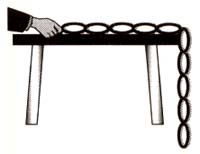Q.
A uniform chain of length $16\,m$ and mass $540\,g$ whose $\frac{2}{3^{rd}}$ part of its length is hanging vertically down over the edge of the table and remaining part on the smooth table. Consider $g$ is $10\,ms^{- 2}$ , then the work required to pull the hanging part on to the table is $\frac{x}{10}J$ . Find $x$ .

NTA AbhyasNTA Abhyas 2022
Solution:
